Customer Loyalty Schemes in Hospitality Sector: Bourne Leisure
VerifiedAdded on 2023/01/11
|28
|7497
|84
Report
AI Summary
This research project delves into the analysis of customer loyalty schemes and cards within the hospitality sector, with a specific focus on Bourne Leisure Ltd. The study aims to understand the significance of customer loyalty schemes, identify the strategies employed by Bourne Leisure, ascertain the challenges faced in their application, and recommend potential solutions. The research employs a questionnaire-based methodology to gather data, ensuring the integrity and authenticity of the findings. The report includes a comprehensive literature review covering the importance of customer loyalty, strategies for influencing customer loyalty, and the challenges in implementing loyalty schemes. The analysis section examines the data collected, followed by a critical appraisal, recommendations, and suggestions for further research. The conclusion summarizes the key findings and insights gained from the investigation. The report provides valuable insights into the effectiveness of customer loyalty schemes and offers practical recommendations for businesses in the hospitality sector seeking to enhance customer retention and satisfaction. The report also highlights the importance of adapting strategies to address the challenges identified, ultimately contributing to improved customer engagement and business success.

Research Project
Paraphrase This Document
Need a fresh take? Get an instant paraphrase of this document with our AI Paraphraser
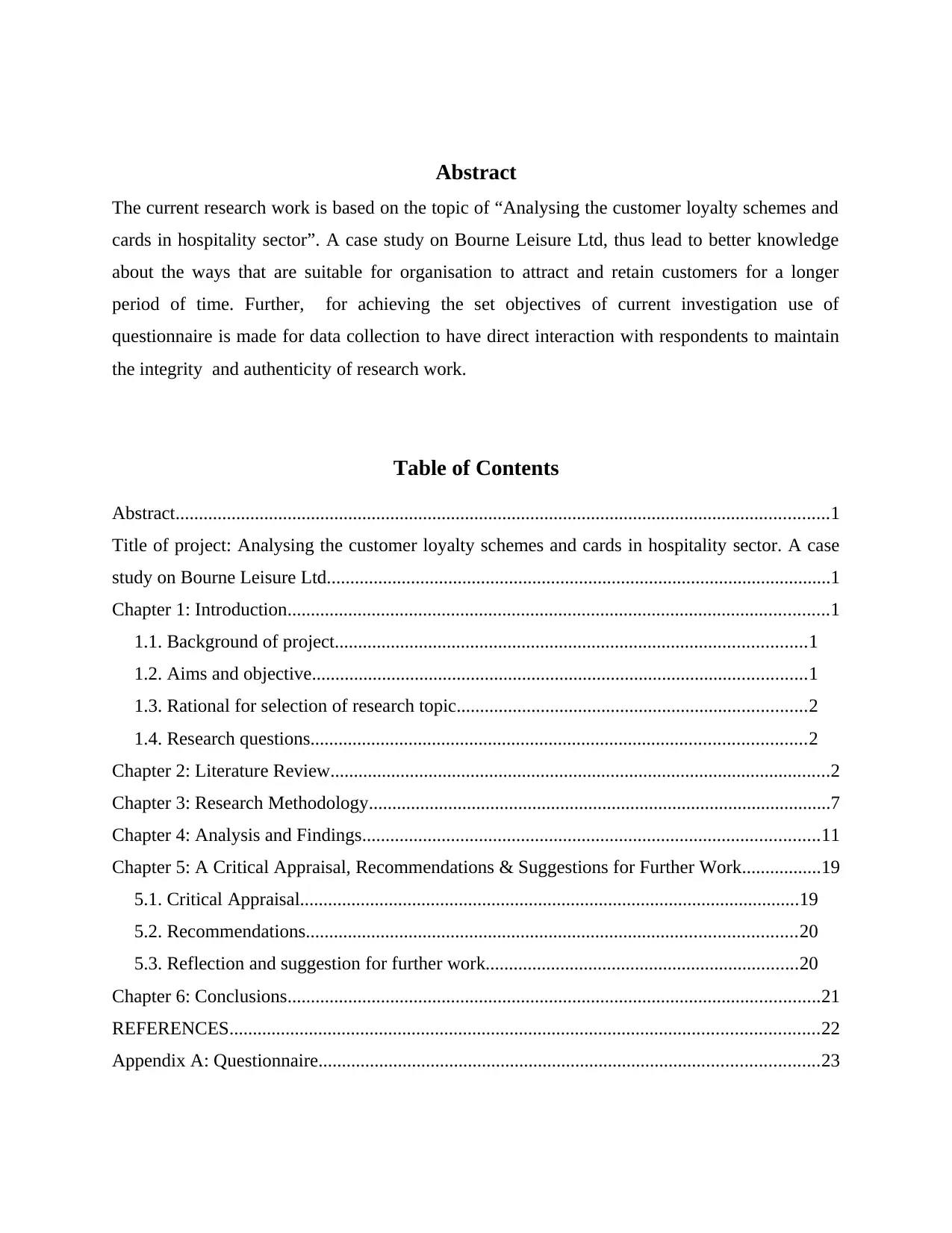
Abstract
The current research work is based on the topic of “Analysing the customer loyalty schemes and
cards in hospitality sector”. A case study on Bourne Leisure Ltd, thus lead to better knowledge
about the ways that are suitable for organisation to attract and retain customers for a longer
period of time. Further, for achieving the set objectives of current investigation use of
questionnaire is made for data collection to have direct interaction with respondents to maintain
the integrity and authenticity of research work.
Table of Contents
Abstract............................................................................................................................................1
Title of project: Analysing the customer loyalty schemes and cards in hospitality sector. A case
study on Bourne Leisure Ltd............................................................................................................1
Chapter 1: Introduction....................................................................................................................1
1.1. Background of project.....................................................................................................1
1.2. Aims and objective..........................................................................................................1
1.3. Rational for selection of research topic...........................................................................2
1.4. Research questions..........................................................................................................2
Chapter 2: Literature Review...........................................................................................................2
Chapter 3: Research Methodology...................................................................................................7
Chapter 4: Analysis and Findings..................................................................................................11
Chapter 5: A Critical Appraisal, Recommendations & Suggestions for Further Work.................19
5.1. Critical Appraisal...........................................................................................................19
5.2. Recommendations.........................................................................................................20
5.3. Reflection and suggestion for further work...................................................................20
Chapter 6: Conclusions..................................................................................................................21
REFERENCES..............................................................................................................................22
Appendix A: Questionnaire...........................................................................................................23
The current research work is based on the topic of “Analysing the customer loyalty schemes and
cards in hospitality sector”. A case study on Bourne Leisure Ltd, thus lead to better knowledge
about the ways that are suitable for organisation to attract and retain customers for a longer
period of time. Further, for achieving the set objectives of current investigation use of
questionnaire is made for data collection to have direct interaction with respondents to maintain
the integrity and authenticity of research work.
Table of Contents
Abstract............................................................................................................................................1
Title of project: Analysing the customer loyalty schemes and cards in hospitality sector. A case
study on Bourne Leisure Ltd............................................................................................................1
Chapter 1: Introduction....................................................................................................................1
1.1. Background of project.....................................................................................................1
1.2. Aims and objective..........................................................................................................1
1.3. Rational for selection of research topic...........................................................................2
1.4. Research questions..........................................................................................................2
Chapter 2: Literature Review...........................................................................................................2
Chapter 3: Research Methodology...................................................................................................7
Chapter 4: Analysis and Findings..................................................................................................11
Chapter 5: A Critical Appraisal, Recommendations & Suggestions for Further Work.................19
5.1. Critical Appraisal...........................................................................................................19
5.2. Recommendations.........................................................................................................20
5.3. Reflection and suggestion for further work...................................................................20
Chapter 6: Conclusions..................................................................................................................21
REFERENCES..............................................................................................................................22
Appendix A: Questionnaire...........................................................................................................23

⊘ This is a preview!⊘
Do you want full access?
Subscribe today to unlock all pages.

Trusted by 1+ million students worldwide
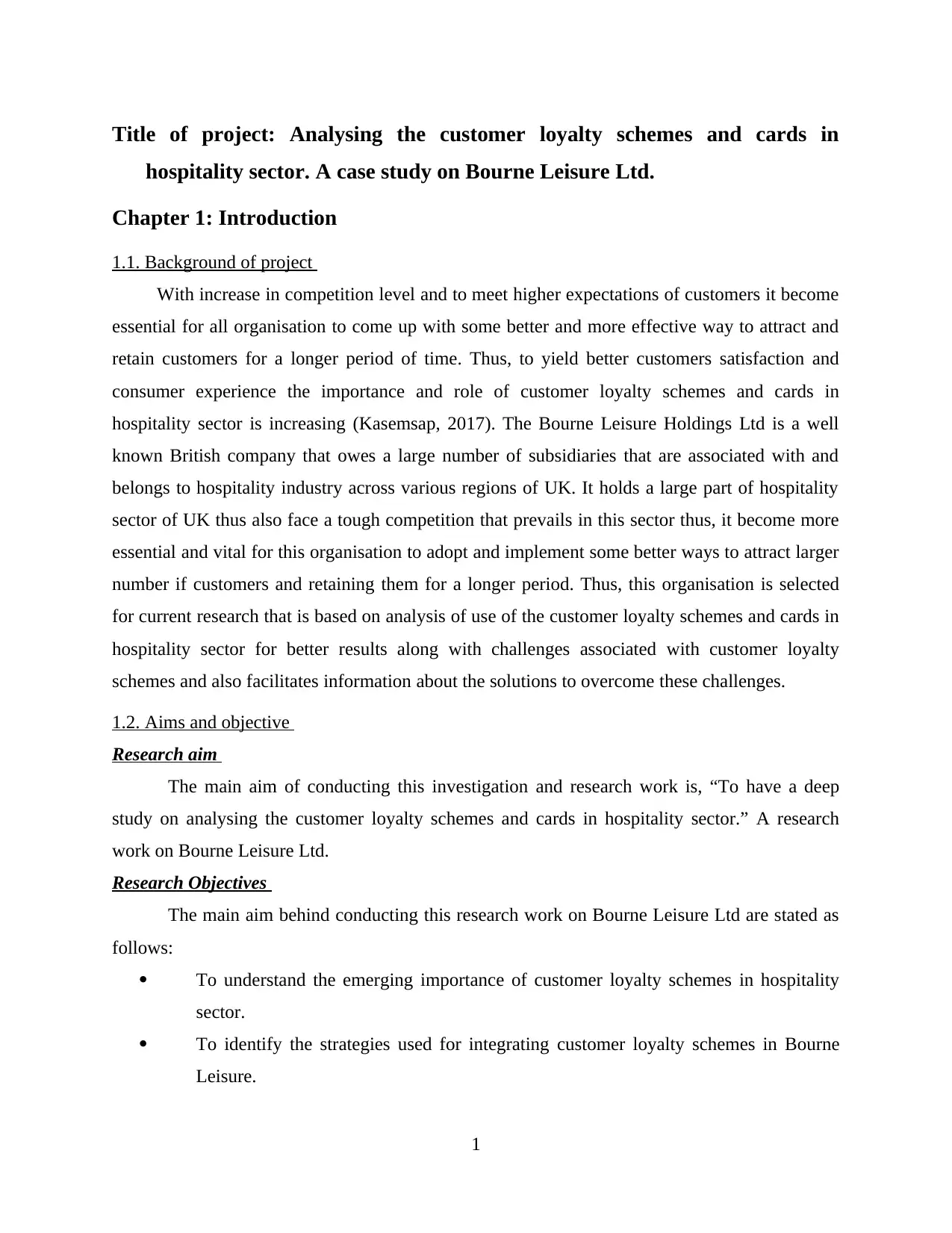
Title of project: Analysing the customer loyalty schemes and cards in
hospitality sector. A case study on Bourne Leisure Ltd.
Chapter 1: Introduction
1.1. Background of project
With increase in competition level and to meet higher expectations of customers it become
essential for all organisation to come up with some better and more effective way to attract and
retain customers for a longer period of time. Thus, to yield better customers satisfaction and
consumer experience the importance and role of customer loyalty schemes and cards in
hospitality sector is increasing (Kasemsap, 2017). The Bourne Leisure Holdings Ltd is a well
known British company that owes a large number of subsidiaries that are associated with and
belongs to hospitality industry across various regions of UK. It holds a large part of hospitality
sector of UK thus also face a tough competition that prevails in this sector thus, it become more
essential and vital for this organisation to adopt and implement some better ways to attract larger
number if customers and retaining them for a longer period. Thus, this organisation is selected
for current research that is based on analysis of use of the customer loyalty schemes and cards in
hospitality sector for better results along with challenges associated with customer loyalty
schemes and also facilitates information about the solutions to overcome these challenges.
1.2. Aims and objective
Research aim
The main aim of conducting this investigation and research work is, “To have a deep
study on analysing the customer loyalty schemes and cards in hospitality sector.” A research
work on Bourne Leisure Ltd.
Research Objectives
The main aim behind conducting this research work on Bourne Leisure Ltd are stated as
follows:
To understand the emerging importance of customer loyalty schemes in hospitality
sector.
To identify the strategies used for integrating customer loyalty schemes in Bourne
Leisure.
1
hospitality sector. A case study on Bourne Leisure Ltd.
Chapter 1: Introduction
1.1. Background of project
With increase in competition level and to meet higher expectations of customers it become
essential for all organisation to come up with some better and more effective way to attract and
retain customers for a longer period of time. Thus, to yield better customers satisfaction and
consumer experience the importance and role of customer loyalty schemes and cards in
hospitality sector is increasing (Kasemsap, 2017). The Bourne Leisure Holdings Ltd is a well
known British company that owes a large number of subsidiaries that are associated with and
belongs to hospitality industry across various regions of UK. It holds a large part of hospitality
sector of UK thus also face a tough competition that prevails in this sector thus, it become more
essential and vital for this organisation to adopt and implement some better ways to attract larger
number if customers and retaining them for a longer period. Thus, this organisation is selected
for current research that is based on analysis of use of the customer loyalty schemes and cards in
hospitality sector for better results along with challenges associated with customer loyalty
schemes and also facilitates information about the solutions to overcome these challenges.
1.2. Aims and objective
Research aim
The main aim of conducting this investigation and research work is, “To have a deep
study on analysing the customer loyalty schemes and cards in hospitality sector.” A research
work on Bourne Leisure Ltd.
Research Objectives
The main aim behind conducting this research work on Bourne Leisure Ltd are stated as
follows:
To understand the emerging importance of customer loyalty schemes in hospitality
sector.
To identify the strategies used for integrating customer loyalty schemes in Bourne
Leisure.
1
Paraphrase This Document
Need a fresh take? Get an instant paraphrase of this document with our AI Paraphraser
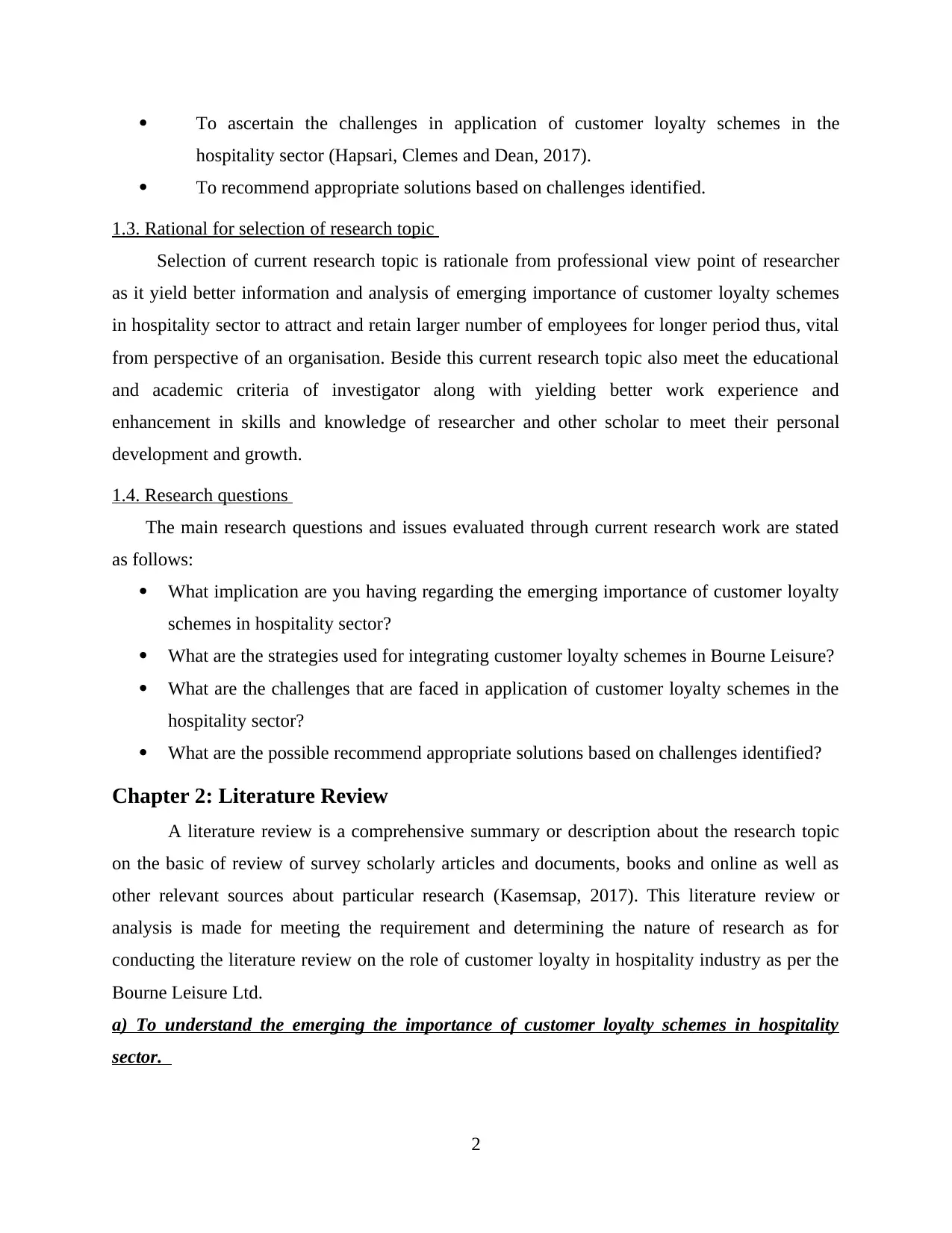
To ascertain the challenges in application of customer loyalty schemes in the
hospitality sector (Hapsari, Clemes and Dean, 2017).
To recommend appropriate solutions based on challenges identified.
1.3. Rational for selection of research topic
Selection of current research topic is rationale from professional view point of researcher
as it yield better information and analysis of emerging importance of customer loyalty schemes
in hospitality sector to attract and retain larger number of employees for longer period thus, vital
from perspective of an organisation. Beside this current research topic also meet the educational
and academic criteria of investigator along with yielding better work experience and
enhancement in skills and knowledge of researcher and other scholar to meet their personal
development and growth.
1.4. Research questions
The main research questions and issues evaluated through current research work are stated
as follows:
What implication are you having regarding the emerging importance of customer loyalty
schemes in hospitality sector?
What are the strategies used for integrating customer loyalty schemes in Bourne Leisure?
What are the challenges that are faced in application of customer loyalty schemes in the
hospitality sector?
What are the possible recommend appropriate solutions based on challenges identified?
Chapter 2: Literature Review
A literature review is a comprehensive summary or description about the research topic
on the basic of review of survey scholarly articles and documents, books and online as well as
other relevant sources about particular research (Kasemsap, 2017). This literature review or
analysis is made for meeting the requirement and determining the nature of research as for
conducting the literature review on the role of customer loyalty in hospitality industry as per the
Bourne Leisure Ltd.
a) To understand the emerging the importance of customer loyalty schemes in hospitality
sector.
2
hospitality sector (Hapsari, Clemes and Dean, 2017).
To recommend appropriate solutions based on challenges identified.
1.3. Rational for selection of research topic
Selection of current research topic is rationale from professional view point of researcher
as it yield better information and analysis of emerging importance of customer loyalty schemes
in hospitality sector to attract and retain larger number of employees for longer period thus, vital
from perspective of an organisation. Beside this current research topic also meet the educational
and academic criteria of investigator along with yielding better work experience and
enhancement in skills and knowledge of researcher and other scholar to meet their personal
development and growth.
1.4. Research questions
The main research questions and issues evaluated through current research work are stated
as follows:
What implication are you having regarding the emerging importance of customer loyalty
schemes in hospitality sector?
What are the strategies used for integrating customer loyalty schemes in Bourne Leisure?
What are the challenges that are faced in application of customer loyalty schemes in the
hospitality sector?
What are the possible recommend appropriate solutions based on challenges identified?
Chapter 2: Literature Review
A literature review is a comprehensive summary or description about the research topic
on the basic of review of survey scholarly articles and documents, books and online as well as
other relevant sources about particular research (Kasemsap, 2017). This literature review or
analysis is made for meeting the requirement and determining the nature of research as for
conducting the literature review on the role of customer loyalty in hospitality industry as per the
Bourne Leisure Ltd.
a) To understand the emerging the importance of customer loyalty schemes in hospitality
sector.
2
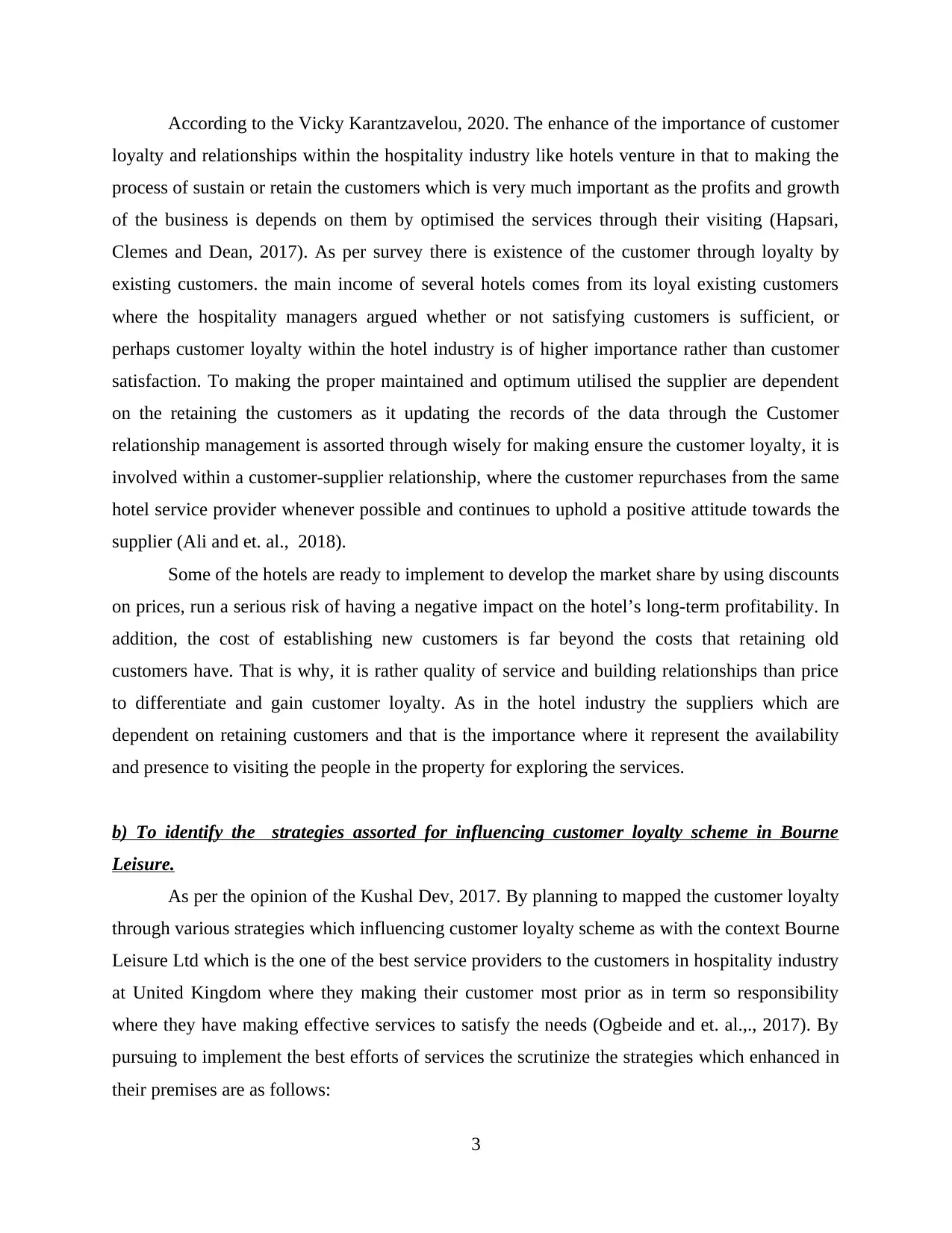
According to the Vicky Karantzavelou, 2020. The enhance of the importance of customer
loyalty and relationships within the hospitality industry like hotels venture in that to making the
process of sustain or retain the customers which is very much important as the profits and growth
of the business is depends on them by optimised the services through their visiting (Hapsari,
Clemes and Dean, 2017). As per survey there is existence of the customer through loyalty by
existing customers. the main income of several hotels comes from its loyal existing customers
where the hospitality managers argued whether or not satisfying customers is sufficient, or
perhaps customer loyalty within the hotel industry is of higher importance rather than customer
satisfaction. To making the proper maintained and optimum utilised the supplier are dependent
on the retaining the customers as it updating the records of the data through the Customer
relationship management is assorted through wisely for making ensure the customer loyalty, it is
involved within a customer-supplier relationship, where the customer repurchases from the same
hotel service provider whenever possible and continues to uphold a positive attitude towards the
supplier (Ali and et. al., 2018).
Some of the hotels are ready to implement to develop the market share by using discounts
on prices, run a serious risk of having a negative impact on the hotel’s long-term profitability. In
addition, the cost of establishing new customers is far beyond the costs that retaining old
customers have. That is why, it is rather quality of service and building relationships than price
to differentiate and gain customer loyalty. As in the hotel industry the suppliers which are
dependent on retaining customers and that is the importance where it represent the availability
and presence to visiting the people in the property for exploring the services.
b) To identify the strategies assorted for influencing customer loyalty scheme in Bourne
Leisure.
As per the opinion of the Kushal Dev, 2017. By planning to mapped the customer loyalty
through various strategies which influencing customer loyalty scheme as with the context Bourne
Leisure Ltd which is the one of the best service providers to the customers in hospitality industry
at United Kingdom where they making their customer most prior as in term so responsibility
where they have making effective services to satisfy the needs (Ogbeide and et. al.,., 2017). By
pursuing to implement the best efforts of services the scrutinize the strategies which enhanced in
their premises are as follows:
3
loyalty and relationships within the hospitality industry like hotels venture in that to making the
process of sustain or retain the customers which is very much important as the profits and growth
of the business is depends on them by optimised the services through their visiting (Hapsari,
Clemes and Dean, 2017). As per survey there is existence of the customer through loyalty by
existing customers. the main income of several hotels comes from its loyal existing customers
where the hospitality managers argued whether or not satisfying customers is sufficient, or
perhaps customer loyalty within the hotel industry is of higher importance rather than customer
satisfaction. To making the proper maintained and optimum utilised the supplier are dependent
on the retaining the customers as it updating the records of the data through the Customer
relationship management is assorted through wisely for making ensure the customer loyalty, it is
involved within a customer-supplier relationship, where the customer repurchases from the same
hotel service provider whenever possible and continues to uphold a positive attitude towards the
supplier (Ali and et. al., 2018).
Some of the hotels are ready to implement to develop the market share by using discounts
on prices, run a serious risk of having a negative impact on the hotel’s long-term profitability. In
addition, the cost of establishing new customers is far beyond the costs that retaining old
customers have. That is why, it is rather quality of service and building relationships than price
to differentiate and gain customer loyalty. As in the hotel industry the suppliers which are
dependent on retaining customers and that is the importance where it represent the availability
and presence to visiting the people in the property for exploring the services.
b) To identify the strategies assorted for influencing customer loyalty scheme in Bourne
Leisure.
As per the opinion of the Kushal Dev, 2017. By planning to mapped the customer loyalty
through various strategies which influencing customer loyalty scheme as with the context Bourne
Leisure Ltd which is the one of the best service providers to the customers in hospitality industry
at United Kingdom where they making their customer most prior as in term so responsibility
where they have making effective services to satisfy the needs (Ogbeide and et. al.,., 2017). By
pursuing to implement the best efforts of services the scrutinize the strategies which enhanced in
their premises are as follows:
3
⊘ This is a preview!⊘
Do you want full access?
Subscribe today to unlock all pages.

Trusted by 1+ million students worldwide
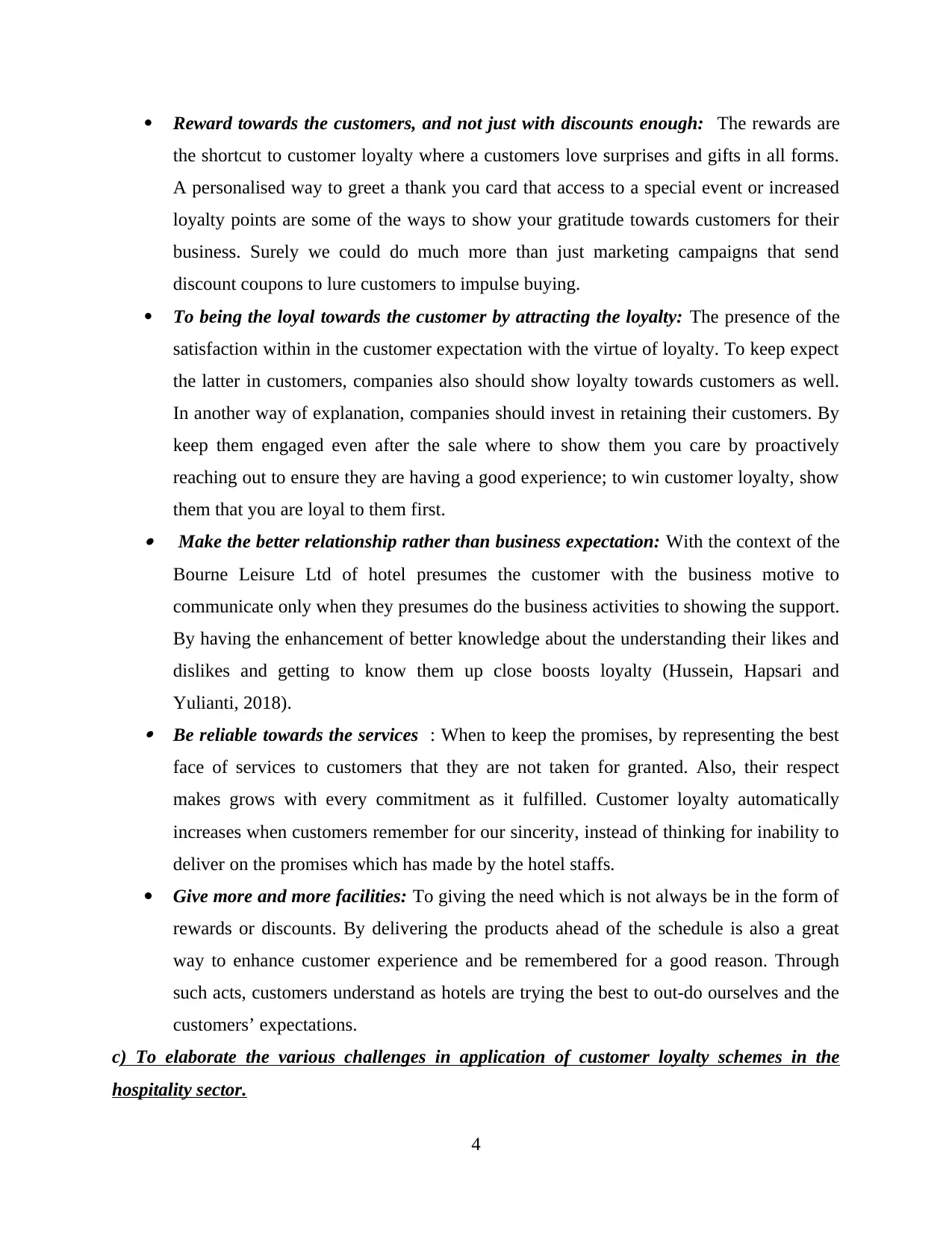
Reward towards the customers, and not just with discounts enough: The rewards are
the shortcut to customer loyalty where a customers love surprises and gifts in all forms.
A personalised way to greet a thank you card that access to a special event or increased
loyalty points are some of the ways to show your gratitude towards customers for their
business. Surely we could do much more than just marketing campaigns that send
discount coupons to lure customers to impulse buying.
To being the loyal towards the customer by attracting the loyalty: The presence of the
satisfaction within in the customer expectation with the virtue of loyalty. To keep expect
the latter in customers, companies also should show loyalty towards customers as well.
In another way of explanation, companies should invest in retaining their customers. By
keep them engaged even after the sale where to show them you care by proactively
reaching out to ensure they are having a good experience; to win customer loyalty, show
them that you are loyal to them first. Make the better relationship rather than business expectation: With the context of the
Bourne Leisure Ltd of hotel presumes the customer with the business motive to
communicate only when they presumes do the business activities to showing the support.
By having the enhancement of better knowledge about the understanding their likes and
dislikes and getting to know them up close boosts loyalty (Hussein, Hapsari and
Yulianti, 2018). Be reliable towards the services : When to keep the promises, by representing the best
face of services to customers that they are not taken for granted. Also, their respect
makes grows with every commitment as it fulfilled. Customer loyalty automatically
increases when customers remember for our sincerity, instead of thinking for inability to
deliver on the promises which has made by the hotel staffs.
Give more and more facilities: To giving the need which is not always be in the form of
rewards or discounts. By delivering the products ahead of the schedule is also a great
way to enhance customer experience and be remembered for a good reason. Through
such acts, customers understand as hotels are trying the best to out-do ourselves and the
customers’ expectations.
c) To elaborate the various challenges in application of customer loyalty schemes in the
hospitality sector.
4
the shortcut to customer loyalty where a customers love surprises and gifts in all forms.
A personalised way to greet a thank you card that access to a special event or increased
loyalty points are some of the ways to show your gratitude towards customers for their
business. Surely we could do much more than just marketing campaigns that send
discount coupons to lure customers to impulse buying.
To being the loyal towards the customer by attracting the loyalty: The presence of the
satisfaction within in the customer expectation with the virtue of loyalty. To keep expect
the latter in customers, companies also should show loyalty towards customers as well.
In another way of explanation, companies should invest in retaining their customers. By
keep them engaged even after the sale where to show them you care by proactively
reaching out to ensure they are having a good experience; to win customer loyalty, show
them that you are loyal to them first. Make the better relationship rather than business expectation: With the context of the
Bourne Leisure Ltd of hotel presumes the customer with the business motive to
communicate only when they presumes do the business activities to showing the support.
By having the enhancement of better knowledge about the understanding their likes and
dislikes and getting to know them up close boosts loyalty (Hussein, Hapsari and
Yulianti, 2018). Be reliable towards the services : When to keep the promises, by representing the best
face of services to customers that they are not taken for granted. Also, their respect
makes grows with every commitment as it fulfilled. Customer loyalty automatically
increases when customers remember for our sincerity, instead of thinking for inability to
deliver on the promises which has made by the hotel staffs.
Give more and more facilities: To giving the need which is not always be in the form of
rewards or discounts. By delivering the products ahead of the schedule is also a great
way to enhance customer experience and be remembered for a good reason. Through
such acts, customers understand as hotels are trying the best to out-do ourselves and the
customers’ expectations.
c) To elaborate the various challenges in application of customer loyalty schemes in the
hospitality sector.
4
Paraphrase This Document
Need a fresh take? Get an instant paraphrase of this document with our AI Paraphraser
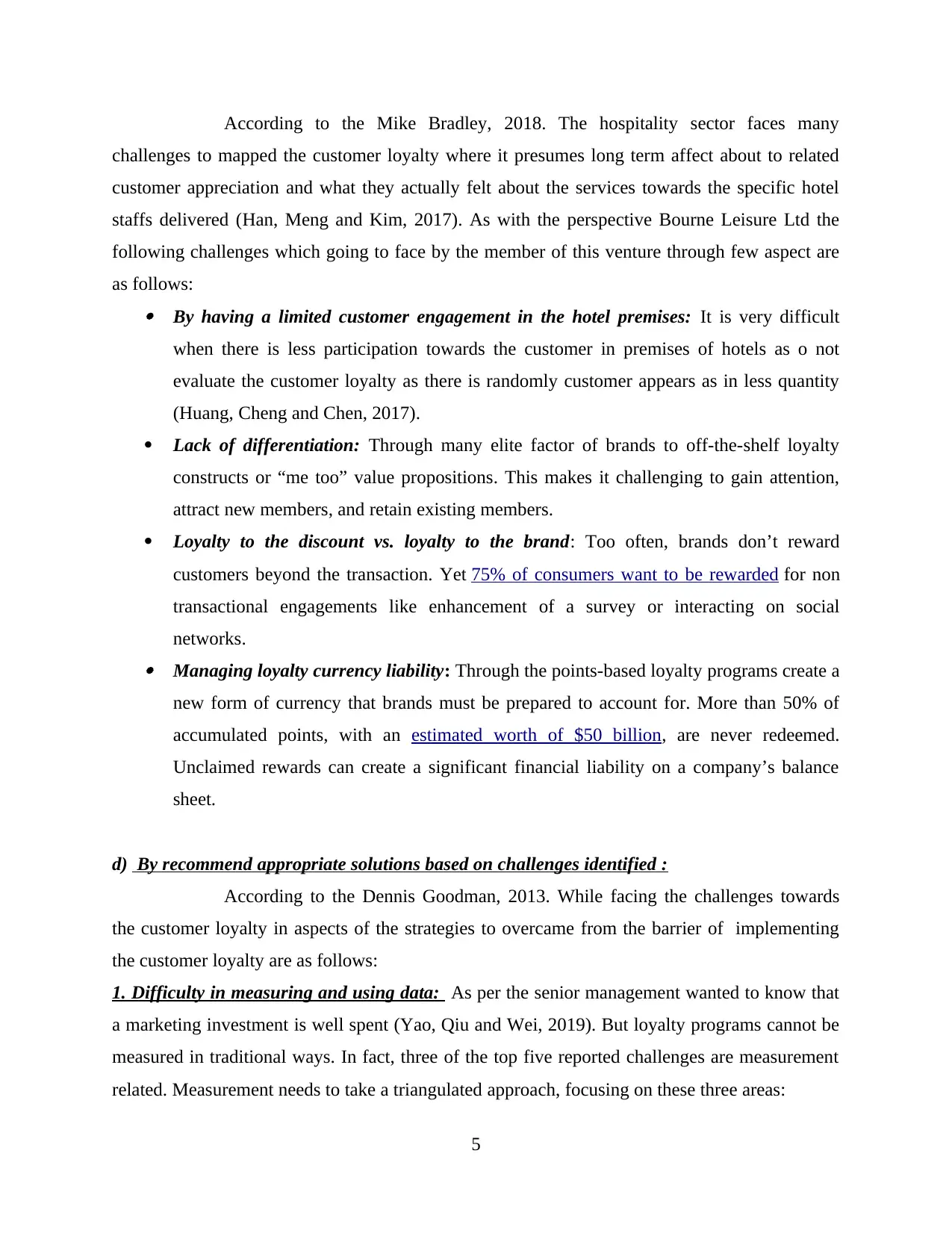
According to the Mike Bradley, 2018. The hospitality sector faces many
challenges to mapped the customer loyalty where it presumes long term affect about to related
customer appreciation and what they actually felt about the services towards the specific hotel
staffs delivered (Han, Meng and Kim, 2017). As with the perspective Bourne Leisure Ltd the
following challenges which going to face by the member of this venture through few aspect are
as follows: By having a limited customer engagement in the hotel premises: It is very difficult
when there is less participation towards the customer in premises of hotels as o not
evaluate the customer loyalty as there is randomly customer appears as in less quantity
(Huang, Cheng and Chen, 2017).
Lack of differentiation: Through many elite factor of brands to off-the-shelf loyalty
constructs or “me too” value propositions. This makes it challenging to gain attention,
attract new members, and retain existing members.
Loyalty to the discount vs. loyalty to the brand: Too often, brands don’t reward
customers beyond the transaction. Yet 75% of consumers want to be rewarded for non
transactional engagements like enhancement of a survey or interacting on social
networks. Managing loyalty currency liability: Through the points-based loyalty programs create a
new form of currency that brands must be prepared to account for. More than 50% of
accumulated points, with an estimated worth of $50 billion, are never redeemed.
Unclaimed rewards can create a significant financial liability on a company’s balance
sheet.
d) By recommend appropriate solutions based on challenges identified :
According to the Dennis Goodman, 2013. While facing the challenges towards
the customer loyalty in aspects of the strategies to overcame from the barrier of implementing
the customer loyalty are as follows:
1. Difficulty in measuring and using data: As per the senior management wanted to know that
a marketing investment is well spent (Yao, Qiu and Wei, 2019). But loyalty programs cannot be
measured in traditional ways. In fact, three of the top five reported challenges are measurement
related. Measurement needs to take a triangulated approach, focusing on these three areas:
5
challenges to mapped the customer loyalty where it presumes long term affect about to related
customer appreciation and what they actually felt about the services towards the specific hotel
staffs delivered (Han, Meng and Kim, 2017). As with the perspective Bourne Leisure Ltd the
following challenges which going to face by the member of this venture through few aspect are
as follows: By having a limited customer engagement in the hotel premises: It is very difficult
when there is less participation towards the customer in premises of hotels as o not
evaluate the customer loyalty as there is randomly customer appears as in less quantity
(Huang, Cheng and Chen, 2017).
Lack of differentiation: Through many elite factor of brands to off-the-shelf loyalty
constructs or “me too” value propositions. This makes it challenging to gain attention,
attract new members, and retain existing members.
Loyalty to the discount vs. loyalty to the brand: Too often, brands don’t reward
customers beyond the transaction. Yet 75% of consumers want to be rewarded for non
transactional engagements like enhancement of a survey or interacting on social
networks. Managing loyalty currency liability: Through the points-based loyalty programs create a
new form of currency that brands must be prepared to account for. More than 50% of
accumulated points, with an estimated worth of $50 billion, are never redeemed.
Unclaimed rewards can create a significant financial liability on a company’s balance
sheet.
d) By recommend appropriate solutions based on challenges identified :
According to the Dennis Goodman, 2013. While facing the challenges towards
the customer loyalty in aspects of the strategies to overcame from the barrier of implementing
the customer loyalty are as follows:
1. Difficulty in measuring and using data: As per the senior management wanted to know that
a marketing investment is well spent (Yao, Qiu and Wei, 2019). But loyalty programs cannot be
measured in traditional ways. In fact, three of the top five reported challenges are measurement
related. Measurement needs to take a triangulated approach, focusing on these three areas:
5
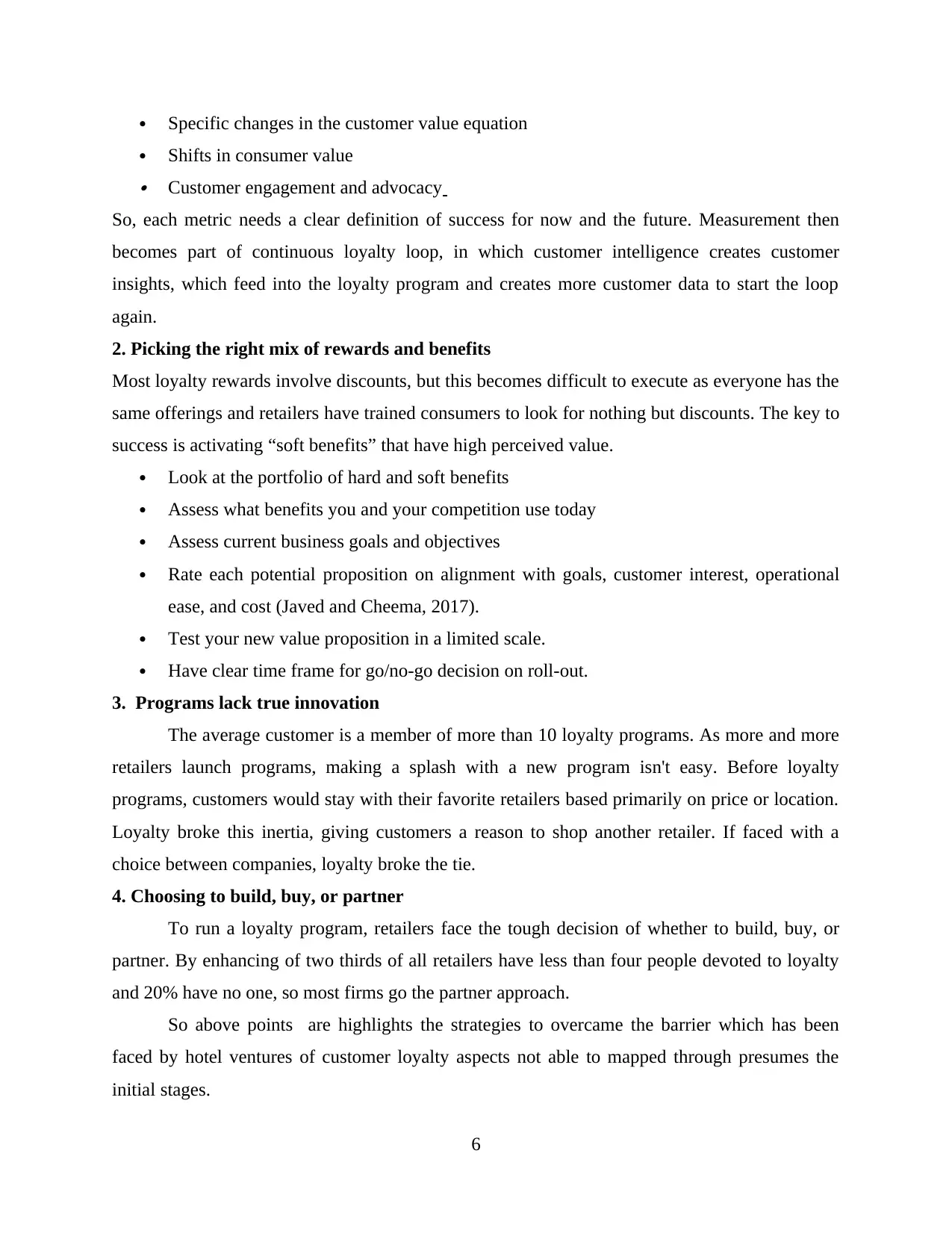
Specific changes in the customer value equation
Shifts in consumer value Customer engagement and advocacy
So, each metric needs a clear definition of success for now and the future. Measurement then
becomes part of continuous loyalty loop, in which customer intelligence creates customer
insights, which feed into the loyalty program and creates more customer data to start the loop
again.
2. Picking the right mix of rewards and benefits
Most loyalty rewards involve discounts, but this becomes difficult to execute as everyone has the
same offerings and retailers have trained consumers to look for nothing but discounts. The key to
success is activating “soft benefits” that have high perceived value.
Look at the portfolio of hard and soft benefits
Assess what benefits you and your competition use today
Assess current business goals and objectives
Rate each potential proposition on alignment with goals, customer interest, operational
ease, and cost (Javed and Cheema, 2017).
Test your new value proposition in a limited scale.
Have clear time frame for go/no-go decision on roll-out.
3. Programs lack true innovation
The average customer is a member of more than 10 loyalty programs. As more and more
retailers launch programs, making a splash with a new program isn't easy. Before loyalty
programs, customers would stay with their favorite retailers based primarily on price or location.
Loyalty broke this inertia, giving customers a reason to shop another retailer. If faced with a
choice between companies, loyalty broke the tie.
4. Choosing to build, buy, or partner
To run a loyalty program, retailers face the tough decision of whether to build, buy, or
partner. By enhancing of two thirds of all retailers have less than four people devoted to loyalty
and 20% have no one, so most firms go the partner approach.
So above points are highlights the strategies to overcame the barrier which has been
faced by hotel ventures of customer loyalty aspects not able to mapped through presumes the
initial stages.
6
Shifts in consumer value Customer engagement and advocacy
So, each metric needs a clear definition of success for now and the future. Measurement then
becomes part of continuous loyalty loop, in which customer intelligence creates customer
insights, which feed into the loyalty program and creates more customer data to start the loop
again.
2. Picking the right mix of rewards and benefits
Most loyalty rewards involve discounts, but this becomes difficult to execute as everyone has the
same offerings and retailers have trained consumers to look for nothing but discounts. The key to
success is activating “soft benefits” that have high perceived value.
Look at the portfolio of hard and soft benefits
Assess what benefits you and your competition use today
Assess current business goals and objectives
Rate each potential proposition on alignment with goals, customer interest, operational
ease, and cost (Javed and Cheema, 2017).
Test your new value proposition in a limited scale.
Have clear time frame for go/no-go decision on roll-out.
3. Programs lack true innovation
The average customer is a member of more than 10 loyalty programs. As more and more
retailers launch programs, making a splash with a new program isn't easy. Before loyalty
programs, customers would stay with their favorite retailers based primarily on price or location.
Loyalty broke this inertia, giving customers a reason to shop another retailer. If faced with a
choice between companies, loyalty broke the tie.
4. Choosing to build, buy, or partner
To run a loyalty program, retailers face the tough decision of whether to build, buy, or
partner. By enhancing of two thirds of all retailers have less than four people devoted to loyalty
and 20% have no one, so most firms go the partner approach.
So above points are highlights the strategies to overcame the barrier which has been
faced by hotel ventures of customer loyalty aspects not able to mapped through presumes the
initial stages.
6
⊘ This is a preview!⊘
Do you want full access?
Subscribe today to unlock all pages.

Trusted by 1+ million students worldwide
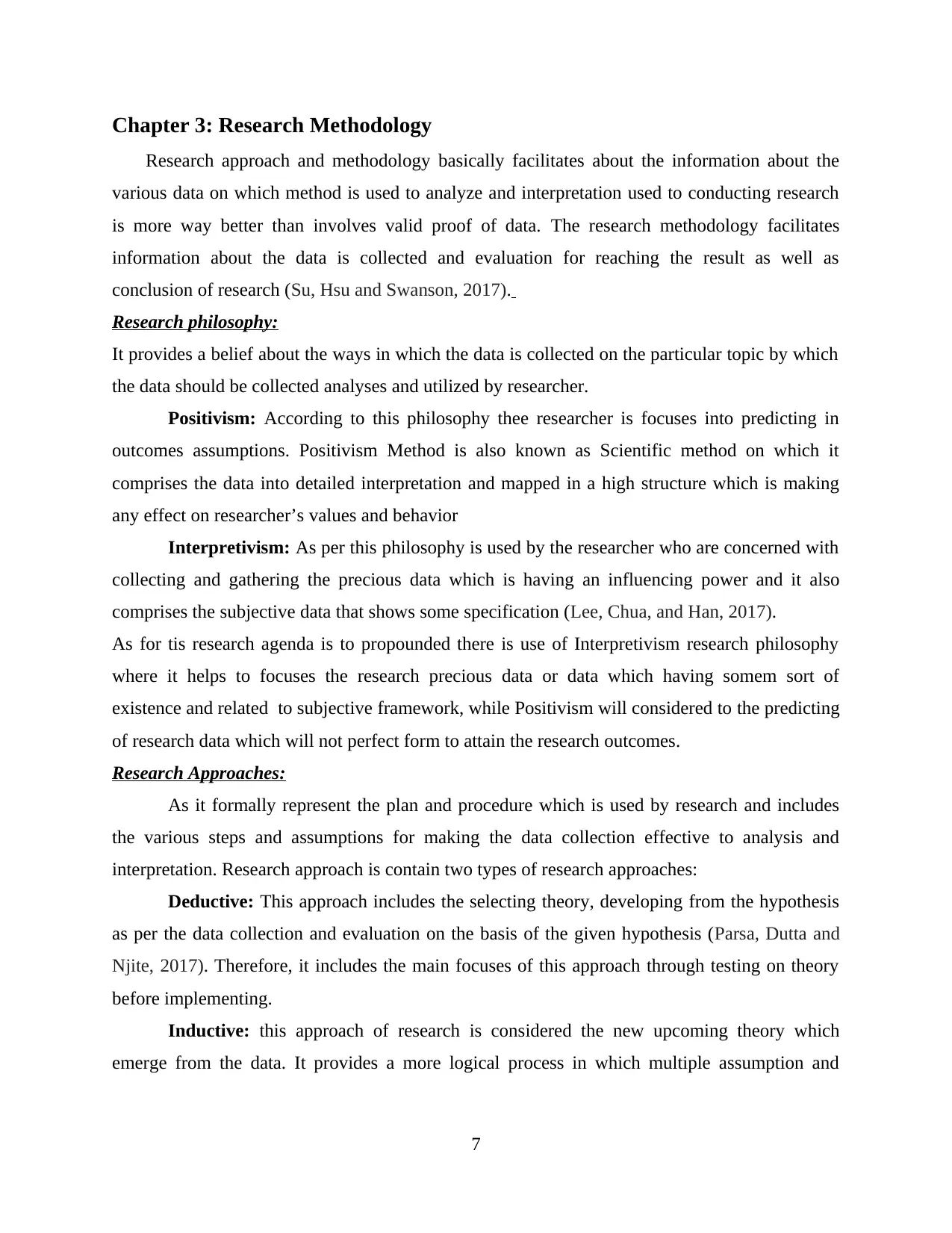
Chapter 3: Research Methodology
Research approach and methodology basically facilitates about the information about the
various data on which method is used to analyze and interpretation used to conducting research
is more way better than involves valid proof of data. The research methodology facilitates
information about the data is collected and evaluation for reaching the result as well as
conclusion of research (Su, Hsu and Swanson, 2017).
Research philosophy:
It provides a belief about the ways in which the data is collected on the particular topic by which
the data should be collected analyses and utilized by researcher.
Positivism: According to this philosophy thee researcher is focuses into predicting in
outcomes assumptions. Positivism Method is also known as Scientific method on which it
comprises the data into detailed interpretation and mapped in a high structure which is making
any effect on researcher’s values and behavior
Interpretivism: As per this philosophy is used by the researcher who are concerned with
collecting and gathering the precious data which is having an influencing power and it also
comprises the subjective data that shows some specification (Lee, Chua, and Han, 2017).
As for tis research agenda is to propounded there is use of Interpretivism research philosophy
where it helps to focuses the research precious data or data which having somem sort of
existence and related to subjective framework, while Positivism will considered to the predicting
of research data which will not perfect form to attain the research outcomes.
Research Approaches:
As it formally represent the plan and procedure which is used by research and includes
the various steps and assumptions for making the data collection effective to analysis and
interpretation. Research approach is contain two types of research approaches:
Deductive: This approach includes the selecting theory, developing from the hypothesis
as per the data collection and evaluation on the basis of the given hypothesis (Parsa, Dutta and
Njite, 2017). Therefore, it includes the main focuses of this approach through testing on theory
before implementing.
Inductive: this approach of research is considered the new upcoming theory which
emerge from the data. It provides a more logical process in which multiple assumption and
7
Research approach and methodology basically facilitates about the information about the
various data on which method is used to analyze and interpretation used to conducting research
is more way better than involves valid proof of data. The research methodology facilitates
information about the data is collected and evaluation for reaching the result as well as
conclusion of research (Su, Hsu and Swanson, 2017).
Research philosophy:
It provides a belief about the ways in which the data is collected on the particular topic by which
the data should be collected analyses and utilized by researcher.
Positivism: According to this philosophy thee researcher is focuses into predicting in
outcomes assumptions. Positivism Method is also known as Scientific method on which it
comprises the data into detailed interpretation and mapped in a high structure which is making
any effect on researcher’s values and behavior
Interpretivism: As per this philosophy is used by the researcher who are concerned with
collecting and gathering the precious data which is having an influencing power and it also
comprises the subjective data that shows some specification (Lee, Chua, and Han, 2017).
As for tis research agenda is to propounded there is use of Interpretivism research philosophy
where it helps to focuses the research precious data or data which having somem sort of
existence and related to subjective framework, while Positivism will considered to the predicting
of research data which will not perfect form to attain the research outcomes.
Research Approaches:
As it formally represent the plan and procedure which is used by research and includes
the various steps and assumptions for making the data collection effective to analysis and
interpretation. Research approach is contain two types of research approaches:
Deductive: This approach includes the selecting theory, developing from the hypothesis
as per the data collection and evaluation on the basis of the given hypothesis (Parsa, Dutta and
Njite, 2017). Therefore, it includes the main focuses of this approach through testing on theory
before implementing.
Inductive: this approach of research is considered the new upcoming theory which
emerge from the data. It provides a more logical process in which multiple assumption and
7
Paraphrase This Document
Need a fresh take? Get an instant paraphrase of this document with our AI Paraphraser
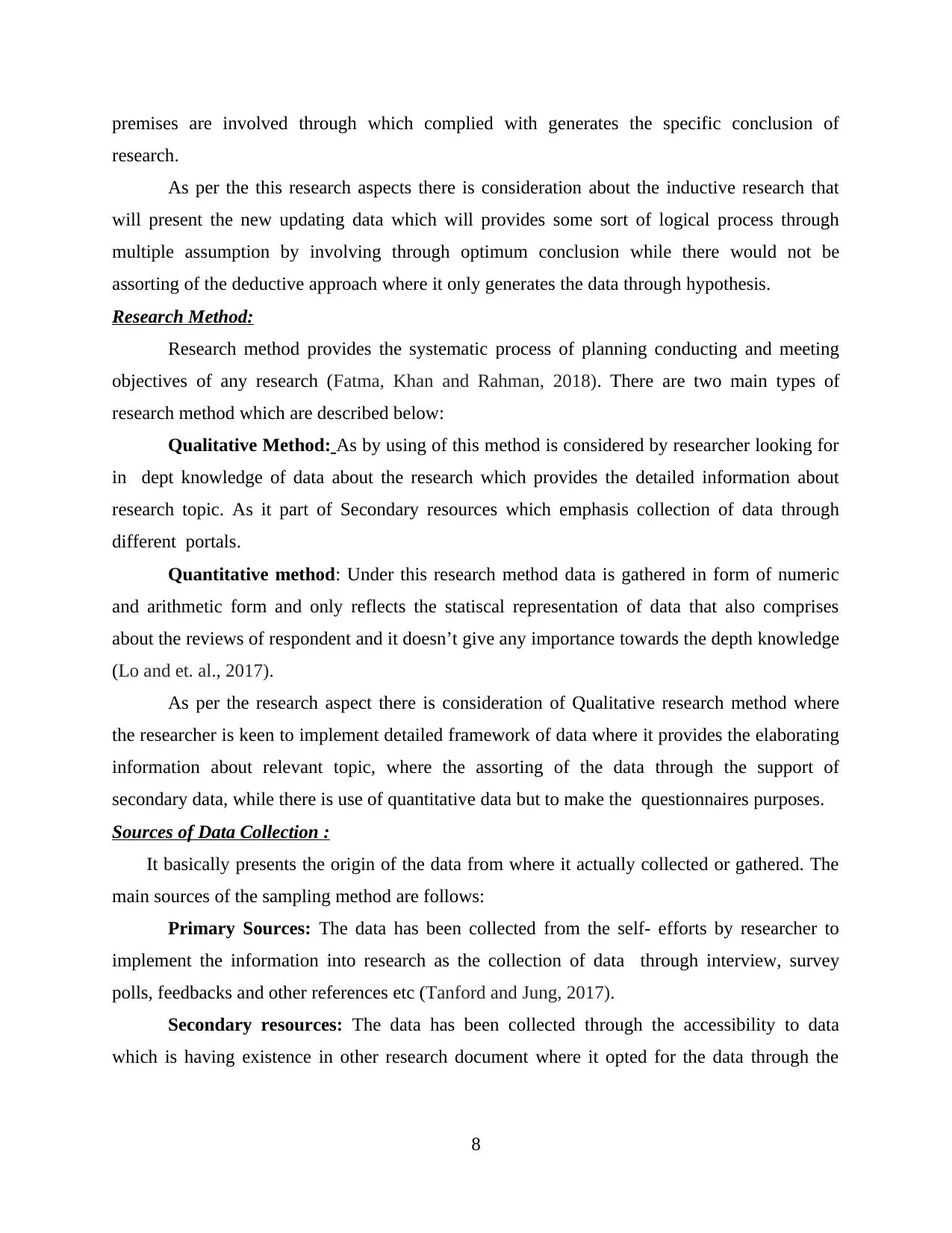
premises are involved through which complied with generates the specific conclusion of
research.
As per the this research aspects there is consideration about the inductive research that
will present the new updating data which will provides some sort of logical process through
multiple assumption by involving through optimum conclusion while there would not be
assorting of the deductive approach where it only generates the data through hypothesis.
Research Method:
Research method provides the systematic process of planning conducting and meeting
objectives of any research (Fatma, Khan and Rahman, 2018). There are two main types of
research method which are described below:
Qualitative Method: As by using of this method is considered by researcher looking for
in dept knowledge of data about the research which provides the detailed information about
research topic. As it part of Secondary resources which emphasis collection of data through
different portals.
Quantitative method: Under this research method data is gathered in form of numeric
and arithmetic form and only reflects the statiscal representation of data that also comprises
about the reviews of respondent and it doesn’t give any importance towards the depth knowledge
(Lo and et. al., 2017).
As per the research aspect there is consideration of Qualitative research method where
the researcher is keen to implement detailed framework of data where it provides the elaborating
information about relevant topic, where the assorting of the data through the support of
secondary data, while there is use of quantitative data but to make the questionnaires purposes.
Sources of Data Collection :
It basically presents the origin of the data from where it actually collected or gathered. The
main sources of the sampling method are follows:
Primary Sources: The data has been collected from the self- efforts by researcher to
implement the information into research as the collection of data through interview, survey
polls, feedbacks and other references etc (Tanford and Jung, 2017).
Secondary resources: The data has been collected through the accessibility to data
which is having existence in other research document where it opted for the data through the
8
research.
As per the this research aspects there is consideration about the inductive research that
will present the new updating data which will provides some sort of logical process through
multiple assumption by involving through optimum conclusion while there would not be
assorting of the deductive approach where it only generates the data through hypothesis.
Research Method:
Research method provides the systematic process of planning conducting and meeting
objectives of any research (Fatma, Khan and Rahman, 2018). There are two main types of
research method which are described below:
Qualitative Method: As by using of this method is considered by researcher looking for
in dept knowledge of data about the research which provides the detailed information about
research topic. As it part of Secondary resources which emphasis collection of data through
different portals.
Quantitative method: Under this research method data is gathered in form of numeric
and arithmetic form and only reflects the statiscal representation of data that also comprises
about the reviews of respondent and it doesn’t give any importance towards the depth knowledge
(Lo and et. al., 2017).
As per the research aspect there is consideration of Qualitative research method where
the researcher is keen to implement detailed framework of data where it provides the elaborating
information about relevant topic, where the assorting of the data through the support of
secondary data, while there is use of quantitative data but to make the questionnaires purposes.
Sources of Data Collection :
It basically presents the origin of the data from where it actually collected or gathered. The
main sources of the sampling method are follows:
Primary Sources: The data has been collected from the self- efforts by researcher to
implement the information into research as the collection of data through interview, survey
polls, feedbacks and other references etc (Tanford and Jung, 2017).
Secondary resources: The data has been collected through the accessibility to data
which is having existence in other research document where it opted for the data through the
8
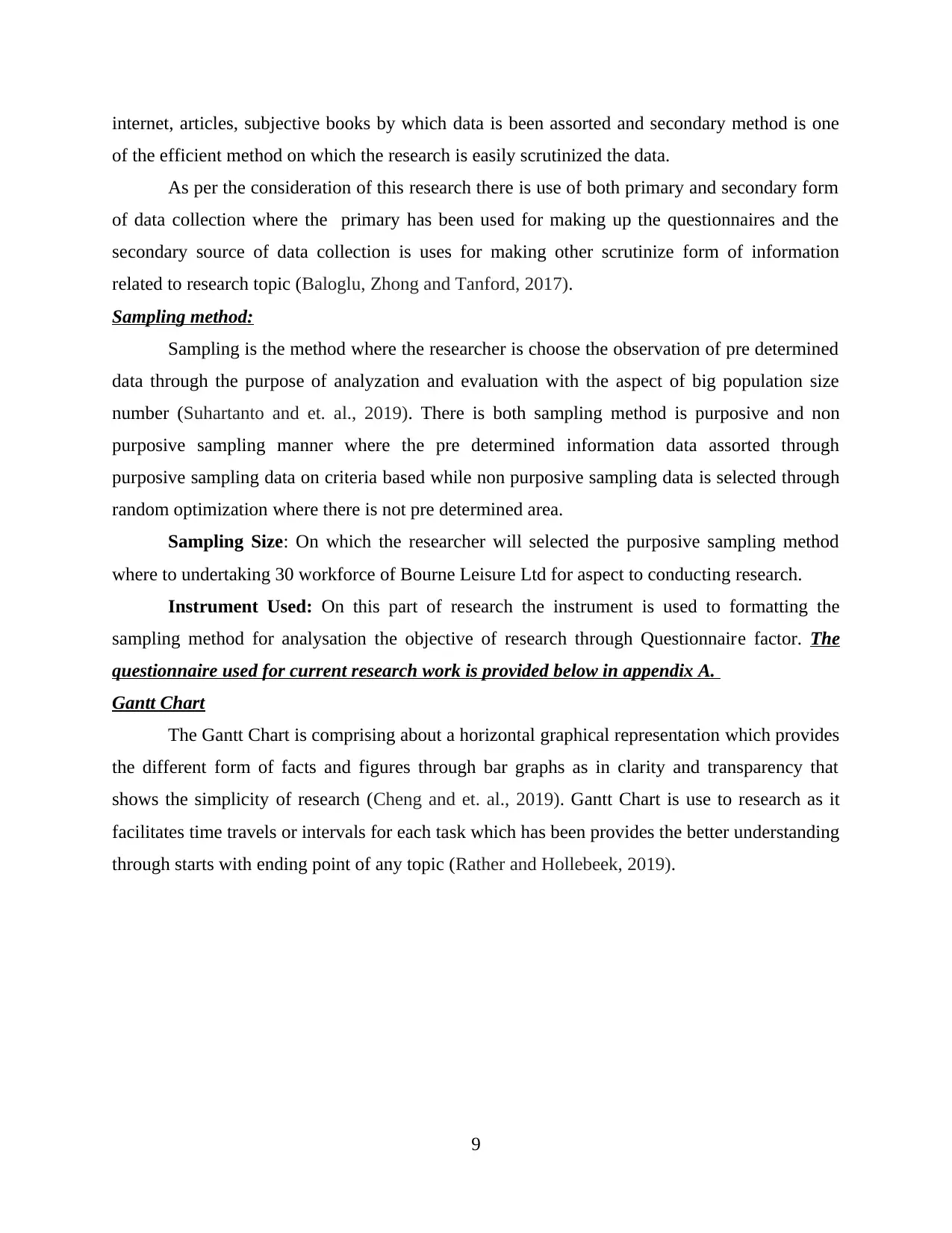
internet, articles, subjective books by which data is been assorted and secondary method is one
of the efficient method on which the research is easily scrutinized the data.
As per the consideration of this research there is use of both primary and secondary form
of data collection where the primary has been used for making up the questionnaires and the
secondary source of data collection is uses for making other scrutinize form of information
related to research topic (Baloglu, Zhong and Tanford, 2017).
Sampling method:
Sampling is the method where the researcher is choose the observation of pre determined
data through the purpose of analyzation and evaluation with the aspect of big population size
number (Suhartanto and et. al., 2019). There is both sampling method is purposive and non
purposive sampling manner where the pre determined information data assorted through
purposive sampling data on criteria based while non purposive sampling data is selected through
random optimization where there is not pre determined area.
Sampling Size: On which the researcher will selected the purposive sampling method
where to undertaking 30 workforce of Bourne Leisure Ltd for aspect to conducting research.
Instrument Used: On this part of research the instrument is used to formatting the
sampling method for analysation the objective of research through Questionnaire factor. The
questionnaire used for current research work is provided below in appendix A.
Gantt Chart
The Gantt Chart is comprising about a horizontal graphical representation which provides
the different form of facts and figures through bar graphs as in clarity and transparency that
shows the simplicity of research (Cheng and et. al., 2019). Gantt Chart is use to research as it
facilitates time travels or intervals for each task which has been provides the better understanding
through starts with ending point of any topic (Rather and Hollebeek, 2019).
9
of the efficient method on which the research is easily scrutinized the data.
As per the consideration of this research there is use of both primary and secondary form
of data collection where the primary has been used for making up the questionnaires and the
secondary source of data collection is uses for making other scrutinize form of information
related to research topic (Baloglu, Zhong and Tanford, 2017).
Sampling method:
Sampling is the method where the researcher is choose the observation of pre determined
data through the purpose of analyzation and evaluation with the aspect of big population size
number (Suhartanto and et. al., 2019). There is both sampling method is purposive and non
purposive sampling manner where the pre determined information data assorted through
purposive sampling data on criteria based while non purposive sampling data is selected through
random optimization where there is not pre determined area.
Sampling Size: On which the researcher will selected the purposive sampling method
where to undertaking 30 workforce of Bourne Leisure Ltd for aspect to conducting research.
Instrument Used: On this part of research the instrument is used to formatting the
sampling method for analysation the objective of research through Questionnaire factor. The
questionnaire used for current research work is provided below in appendix A.
Gantt Chart
The Gantt Chart is comprising about a horizontal graphical representation which provides
the different form of facts and figures through bar graphs as in clarity and transparency that
shows the simplicity of research (Cheng and et. al., 2019). Gantt Chart is use to research as it
facilitates time travels or intervals for each task which has been provides the better understanding
through starts with ending point of any topic (Rather and Hollebeek, 2019).
9
⊘ This is a preview!⊘
Do you want full access?
Subscribe today to unlock all pages.

Trusted by 1+ million students worldwide
1 out of 28
Related Documents
Your All-in-One AI-Powered Toolkit for Academic Success.
+13062052269
info@desklib.com
Available 24*7 on WhatsApp / Email
![[object Object]](/_next/static/media/star-bottom.7253800d.svg)
Unlock your academic potential
Copyright © 2020–2025 A2Z Services. All Rights Reserved. Developed and managed by ZUCOL.





